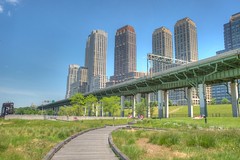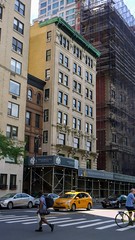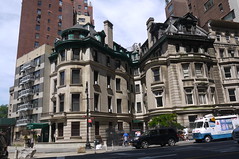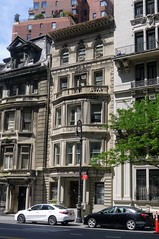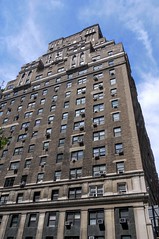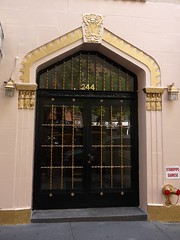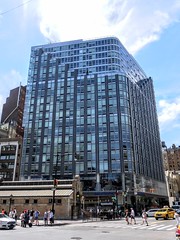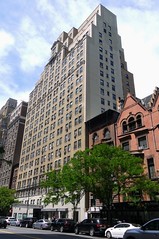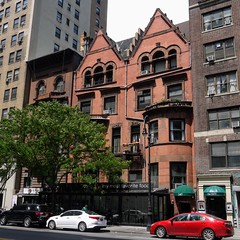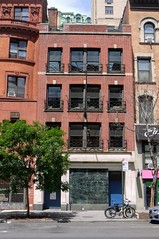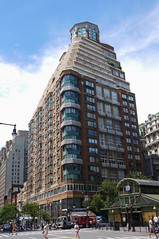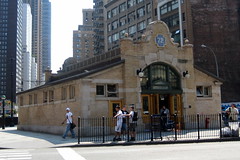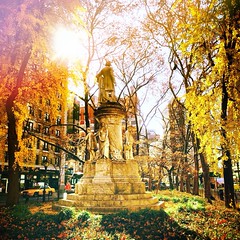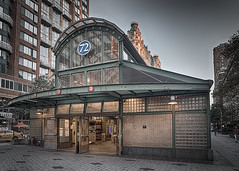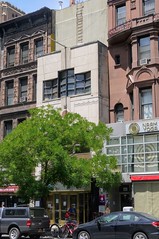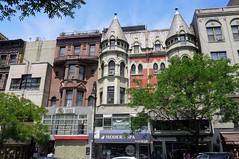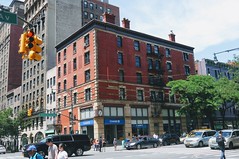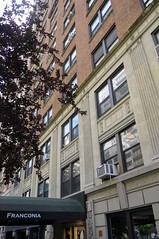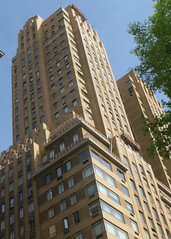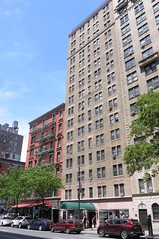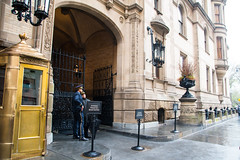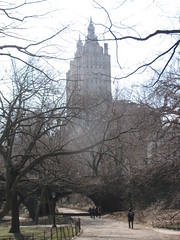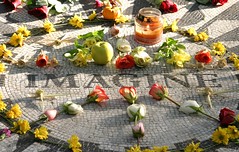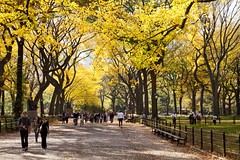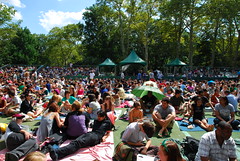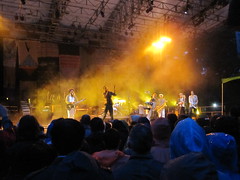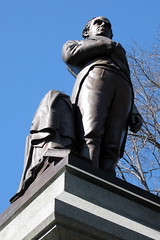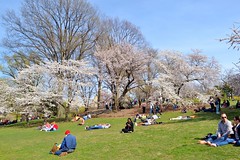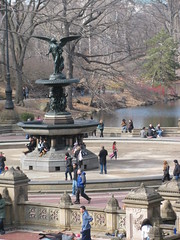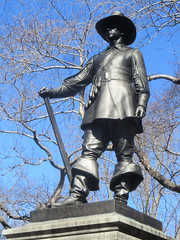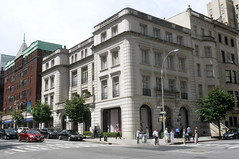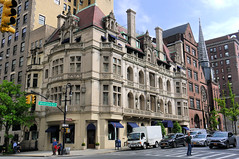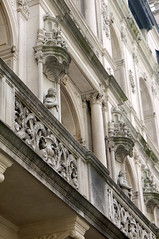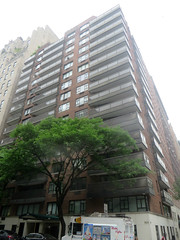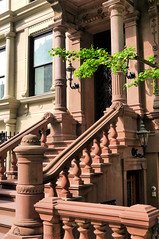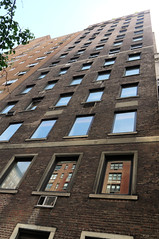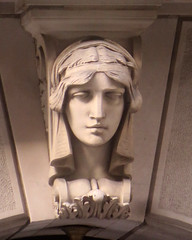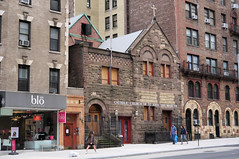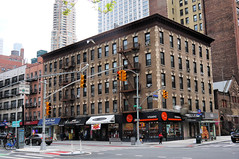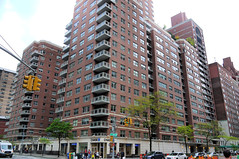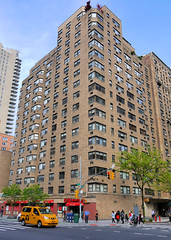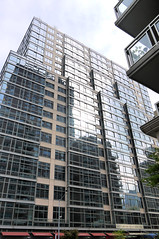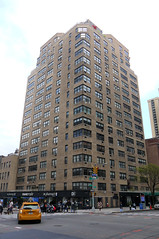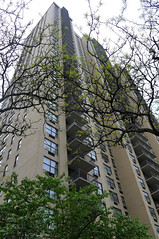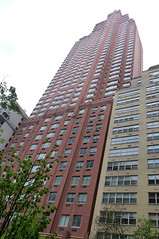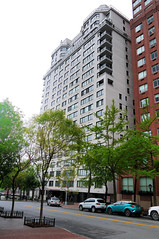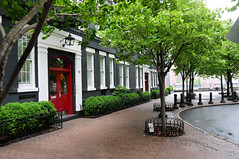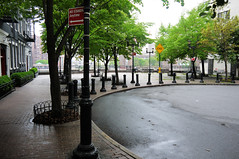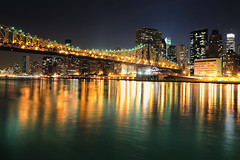South:
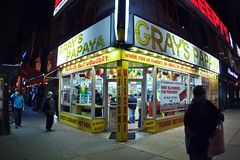
Corner (2090 Broad- way): The original location of the iconic bargain hot dog shop,
which also features deliciously chalky fruit beverages. Gray's often appears in
popular culture—The Warriors, You've Got Mail, Sex and the City, How I Met
Your Mother—as a signifier of real New Yorkiness.
176: Grandaisy Bakery, spinoff of a Tribeca bakery.
174: Built in 1886 as a mansion for lard refiner Albert Seeley Roe;
architect Arthur Bates Jennings
created a Romanesque/Flemish fantasia, in which "no two openings were alike"
(Daytonian).
There were originally four of these; this is the only survivor.
In 1919, the lower floors were clumsily converted into commercial space—originally the
Piccadilly Tea Room. In 1937–38, it was home to Benny Leonard's Restaurant; Leonard, a Jewish boxer
known as the Ghetto Wizard, is reckoned as
one of the top 10 fighters of all time. When taken to court by a waiter who accused him of
punching him for taking a baked potato for his dinner, Leonard told the judge, �If I had hit him,
he wouldn�t have been able to come for a summons.� From 1970–99, the space was the beloved
dive bar
Donohue's, then from 1999-2012, the slightly more upscale
PD O'Hurley's—which lingered briefly up the street when chased out of here by rising rents.
172: Another house by Arthur Bates Jennings was home to Mr. and Mrs. Julian P. Thomas,
famous balloon adventurers in the first decade of the 20th century.
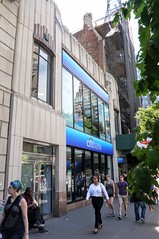
170: This Art Deco storefront was built in 1931 as a two-story
Horn & Hardart automat, which closed in 1967.
166: A 12-story building from 1911. Had a
sign on the north side saying
"depression was a flaw in chemistry not character" from the 1990s until 2016. My Pie Pizzeria Romana is
on the ground floor.
162: Gartner's Hardware, opened 1947
160: Acker Merrall & Condit, the US's oldest
wine merchant, founded in 1820. In 2014 it
settled a lawsuit from billionaire William
Koch accusing them of selling him counterfeit wine.
158:
The Triad, off-Broadway theater built in 1984 best known for the spoof Forbidden Broadway;
Brooke Shields, Matthew Broderick and Ryan Reynolds are among the stars who have performed here.
"In the 1980s, Christopher Walken, Elizabeth Taylor, Liza Minnelli,
Jack Nicholson, Robert DeNiro and many other well-known performers would use the theater
for their own weekly private performances," the venue's website asserts.
Seven's Turkish Grill is also at this address.
156: Le Petit Kids, children's clothes
154: Dark Bullet Oyster & Sake Bar
146: Divorce Center
142: Zurutto, gyoza & ramen bar

138:
Fine & Schapiro, classic kosher deli, opened in 1927 and hasn't changed much since.
Said to be the oldest kosher restaurant in the city.
134: Zen Medica Vitamins
130: Milk & Honey
124: Simit + Smith, Turkish sandwiches
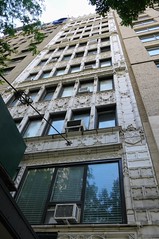
118: Thirteen stories built as the Earlton Studios in 1915, designed by
Buchman & Fox.
The developer,
Edward West Browning (whose initials are entwined above the second floor), went on to be the focus of tabloid scandal when he courted
and married 15-year-old
Peaches Heenan — a May/December romance that lasted from March to October, 1926,
from their meeting at a sorority dance at the Hotel McAlpin to their filing for separation on the grounds of cruelty and abandonment.

112: Originally the Hotel Hargrave, completed 1902, designed by Frederick C. Browne (
Daytonian). Jose Santos Zelaya, president of Nicaragua from 1893–1909, hid out here in 1913 after
being deposed by an invasion of US Marines. He was smuggled out of the hotel in a trunk. In 1951,
James Dean shacked up here with dancer Liz "Dizzy" Sheridan; she later played Jerry's mom on Seinfeld.
Today there's a Ricky's on the ground floor.
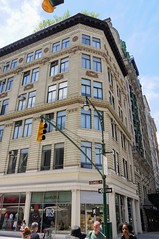
100 (corner):
Park & Tilford Building, a McKim, Mead & White building from 1893, housed the Park & Tilford
luxury grocery store; the Times said of the six-story Renaissance Revival building, "There is no business building more
handsome on the West Side." It almost burned down on December 17, 1916, when ammonia tanks for refrigeration
in the sub-basement exploded. After Park & Tilford sold the building in 1920, it became known as
the Papae building; 150 people were arrested here on March 12, 1935, for "participating in or attending an
indecent performance."
At this corner on November 22, 1911, sewer workers in a shed here set off a
massive
explosion by "toasting" frozen dynamite to thaw it out. One person was killed and several injured.
| 